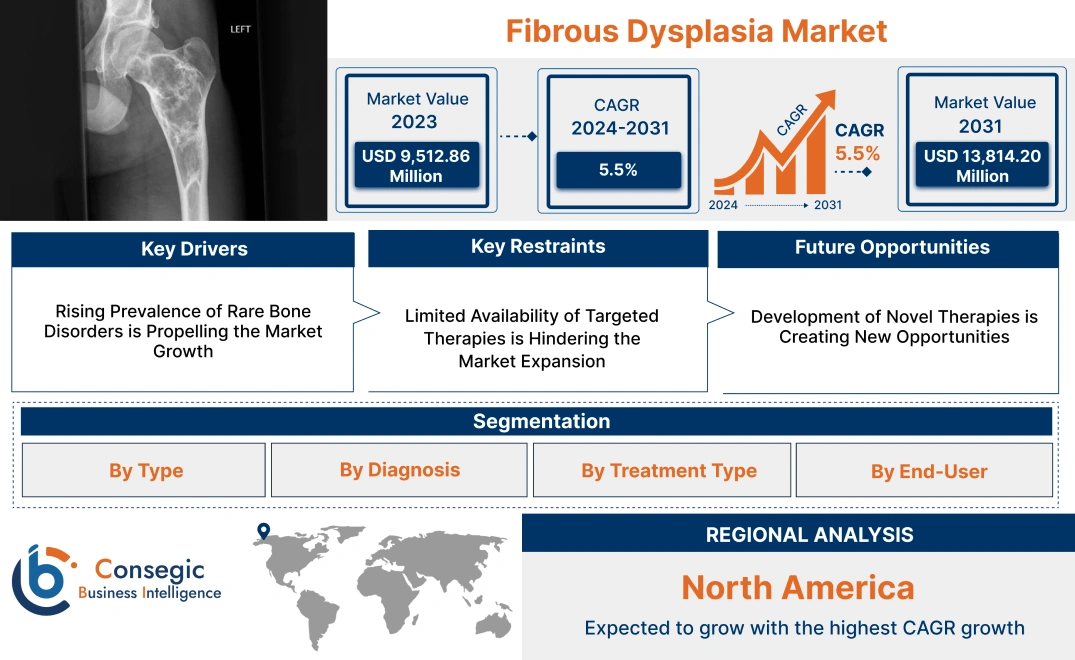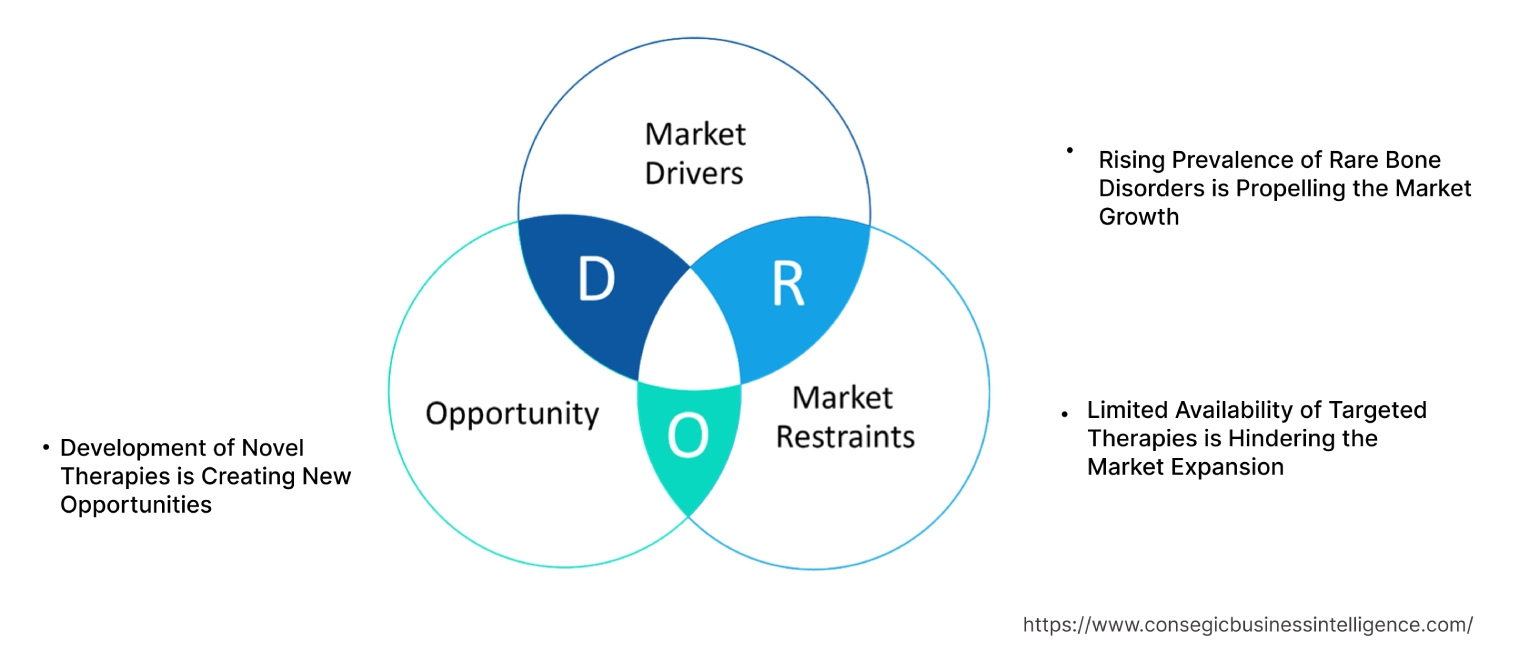- Summary
- Table Of Content
- Methodology
Fibrous Dysplasia Market Size:
Fibrous Dysplasia Market size is estimated to reach over USD 14,626.50 Million by 2032 from a value of USD 9,786.09 Million in 2024 and is projected to grow by USD 10,120.02 Million in 2025, growing at a CAGR of 5.5% from 2025 to 2032.
Fibrous Dysplasia Market Scope & Overview:
Fibrous dysplasia is a chronic disorder that occurs when abnormal fibrous tissue replaces healthy bone tissue. Also, the various types include monostotic fibrous dysplasia, polyostotic fibrous dysplasia, and McCune-Albright syndrome (MAS). Additionally, some of the symptoms include bone deformity, bone fractures, and bone pain, among others. Further, the tools utilized to diagnose the issue include X-rays, magnetic resonance imaging (MRI), computed tomography (CT), bone scintigraphy, and genetic testing, which in turn is fueling the fibrous dysplasia market growth. Furthermore, the cure involves medical treatments that are used to manage symptoms, fix deformities, and enhance the well-being of patients is driving the fibrous dysplasia market demand.
Fibrous Dysplasia Market Insights:
Key Drivers:
Rising Healthcare Expenditure is Propelling the Market Growth
The rising focus on increasing expenditure in healthcare by developing capacity for diagnosis, treatment, and management of rare conditions is fueling the fibrous dysplasia market growth. Additionally, increasing expenditure helps to leverage advanced imaging techniques which in turn is driving the market progress. Further, financial growth also supports research and development activities, fostering innovation in FD treatment and driving the fibrous dysplasia market demand.
- For instance, according to the Indian Ministry of Finance, total health expenditure increased from 29% in FY15 to 48% in FY22 is paving the way for healthcare development.
Therefore, the rising focus on increasing expenditure in healthcare is driving the adoption of advanced technology for treatment, in turn proliferating the fibrous dysplasia industry.
Key Restraints :
High Cost of Treatment is Limiting the Market
The high cost of treatment poses a significant barrier to the widespread adoption of optimal care, thereby limiting the market's potential. The rising demand to cure deformities, manage fractures, and alleviate pain is expensive, especially for patients without comprehensive insurance coverage, which in turn is hindering the fibrous dysplasia market expansion. Further, the cost to regularly monetize patients through advanced imaging techniques is hindering the market's progress.
Therefore, the high costs of treatment are hindering the fibrous dysplasia market expansion due to patients without comprehensive insurance coverage.
Future Opportunities :
Technological Advancements are Expected to Promote Potential Opportunities for Market Growth
The ongoing advancement in improving diagnostic techniques, such as high-resolution CT and MRI, offers advanced visualization of lesions for more accurate diagnoses, which in turn is fueling the fibrous dysplasia market opportunities. Further, the increasing need to enhance the precision and outcomes of corrective surgeries, such as genetic testing, provides specific genetic mutation analysis is boosting the market development. Furthermore, advanced techniques and tools help to personalize medicine strategies based on individual patient profiles for targeted treatments is driving the market growth.
- For instance, in February 2025, Royal Philips received its EU Medical Device Regulation certification for remote scanning capability. The aim is to provide improved diagnostic confidence and patient outcomes.
Hence, the advancement in improving diagnostic techniques is anticipated to increase the utilization, in turn promoting prospects for fibrous dysplasia market opportunities during the forecast period.
Fibrous Dysplasia Market Segmental Analysis :
By Type:
Based on type, the market is segmented into monostotic fibrous dysplasia, polyostotic fibrous dysplasia, and McCune-Albright syndrome (MAS).
Trends in the Type:
- The rising number of specialized orthopedic centers and clinics for providing comprehensive care for monostotic fibrous dysplasia is driving the fibrous dysplasia market trends.
- The expanding research and development of treatment and management of various bone disorders is boosting the fibrous dysplasia market trends.
Monostotic Fibrous Dysplasia accounted for the largest revenue share in the year 2024.
- Monostotic fibrous dysplasia affects a single bone, making it the most common form of this rare bone disorder.
- Further, high demand for diagnostic imaging services such as X-rays, CT scans, and MRIs is fueling the fibrous dysplasia Market size.
- For instance, the monostotic variant is significantly more common, accounting for 70-80% of cases. Additionally, the variant is usually asymptomatic, and it may occur into adulthood.
- Thus, according to the fibrous dysplasia market analysis, the monostotic type accounted for the largest revenue in the market due to the need for surgical and diagnostic services.
Polyostotic Fibrous Dysplasia is anticipated to register the fastest CAGR during the forecast period.
- Polyostotic fibrous dysplasia is more complex due to its involvement of multiple bones.
- Additionally, the type requires more specialized and innovative treatment approaches, which in turn is driving the need for targeted therapies.
- Further, advanced technology such as advanced surgical techniques or novel pharmaceutical interventions is fueling the fibrous dysplasia market size.
- For instance, polyostotic fibrous dysplasia is often shown in T1-weighted MRI scans, which show low to intermediate signal intensity when compared to normal bone marrow.
- Thus, according to the fibrous dysplasia market analysis, advances in diagnosis and treatment are anticipated to boost the market during the forecast period.
By Diagnosis:
Based on diagnosis, the market is segmented into X-rays, magnetic resonance imaging (MRI), computed tomography (CT), bone scintigraphy, and genetic testing.
Trends in the Diagnosis:
- X-ray systems are advancing rapidly by providing better resolution and faster results, which is preferable to patients and healthcare providers, which in turn is fueling the market trends.
- The trend towards continuous advancement in genetic mutations for a better understanding of the condition associated with fibrous dysplasia.
X-rays accounted for the largest revenue share in the year 2024.
- X-rays are a standard and widely used diagnostic tool in clinical settings, contributing to high revenue generation.
- Further, the advancement in x-ray technology provides improved image quality and reduced radiation exposure.
- X-rays are widely used in medical training and research and are an integral part of educational programs for radiology and orthopedics.
- For instance, according to Stanford Medicine, X-ray is an investigative test to produce images of internal tissues, bones, and organs onto film for a better understanding of the disease.
- Thus, as per the market analysis, cost-effectiveness and widespread use are driving the fibrous dysplasia market share.
Genetic Testing is anticipated to register the fastest CAGR during the forecast period.
- Genetic testing allows for the identification of specific mutations associated with the disease, and early diagnosis helps to improve treatment outcomes and management strategies.
- Further, the rise in more precise diagnoses and personalized treatment approaches is fueling the market development.
- Furthermore, improvements in genetic sequencing technologies have made genetic testing more accurate and faster.
- Therefore, as per the market analysis, the advancements in technology to provide more precise diagnoses and personalized treatment approaches are anticipated to boost the market during the forecast period.
By Treatment Type:
Based on the treatment type, the market is segmented into medications (bisphosphonate, hormonal therapy, and analgesics), surgery (corrective surgery, bone grafting), physical therapy, and others.
Trends in the Treatment Type:
- The trend towards technological advancement in 3D-printed scaffolds and improved biomaterials contributes to their growing adoption.
Medications (Bisphosphonates) accounted for the largest revenue share in the year 2024.
- Bisphosphonates are known for their effectiveness in increasing bone density and reducing the risk of fractures, as well as helping mitigate some of the symptoms and complications.
- Further, the ongoing research into improving efficacy and safety of bisphosphonates for the disease is fueling the fibrous dysplasia market share.
- For instance, as per Cleveland Clinique, risedronate reduces the risk of vertebral and nonvertebral fractures by about 40%
- Thus, as per the market analysis, increasing focus on improving bone density and reducing pain is driving the adoption of medications (bisphosphonates).
Surgery (Bone Grafting) is anticipated to register the fastest CAGR during the forecast period.
- Bone grafting is primarily utilized for managing bone defects, deformities, and fractures caused by conditions such as fibrous dysplasia.
- Further, the rising adoption of synthetic materials and biological grafts in advanced bone grafting techniques is fueling the market evolution.
- Therefore, as per the market analysis, improved outcomes, technological advancements, and increased patient demand are anticipated to boost the market during the forecast period.
By End-User:
Based on end user, the market is segmented into hospitals, specialty clinics, diagnostic centers, and rehabilitation centers.
Trends in the End User:
- The trend towards integration of AI and machine learning into diagnostic imaging for the detection and analysis of dysplasia lesions.
- The rising adoption of virtual reality, robotic-assisted therapy, and telerehabilitation in rehabilitation centers is fueling the market evolution.
The hospital accounted for the largest revenue share of 39.15% in the year 2024.
- Hospitals provide a wide range of specialized services, including advanced diagnostic tools like CT scans and MRIs, surgical interventions, and long-term management options.
- Further, the rising adoption of advanced technologies by hospitals for offering advanced treatment options and technologies is propelling the market adoption in hospitals.
- For instance, Rainbow Children's Hospital is a leading provider of pediatric orthopedic facilities, offering specialized and comprehensive care to children diagnosed with the disease.
- Thus, the rising range of advanced diagnostic and treatment services in hospitals is driving the market's progress.
Specialty Clinics is anticipated to register the fastest CAGR during the forecast period.
- Specialty clinics have expertise in providing more precise and effective diagnosis and treatment.
- Additionally, the specialty clinics provide a range of services such as diagnostics, medical management, and surgical options, among others.
- Further, the specialty clinics are gaining popularity due to a higher level of care and attention, which attracts more patients.
- Therefore, the rising focus on offering tailored treatment options and advancements in medical technology are anticipated to boost the market during the forecast period.
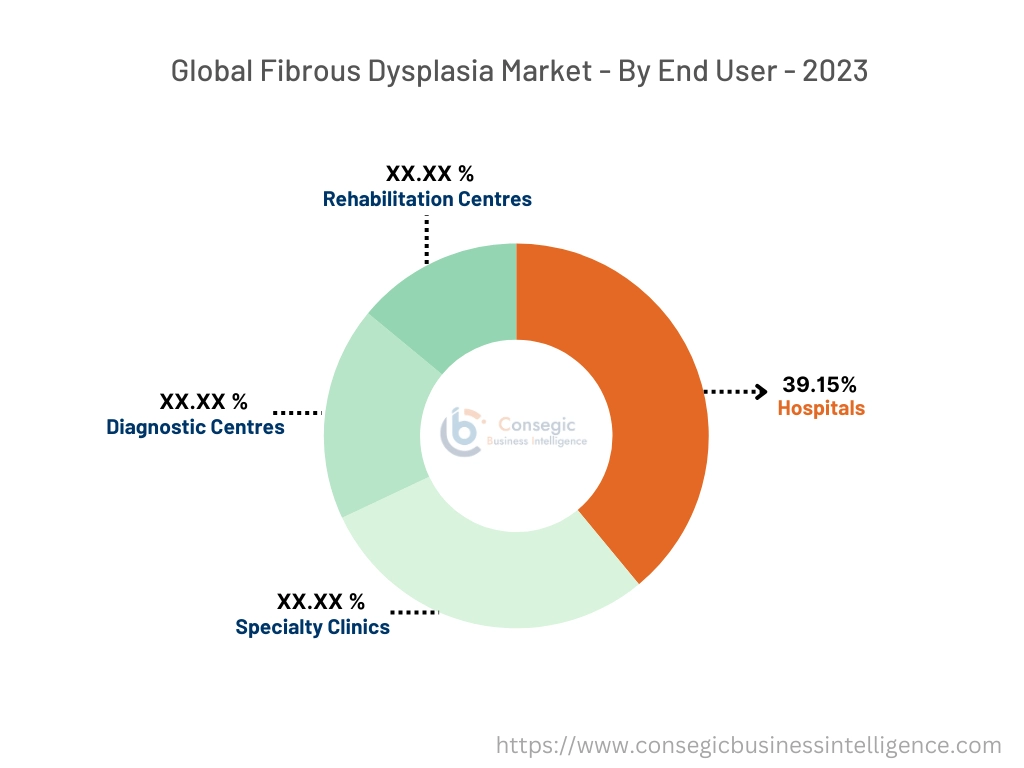
Regional Analysis:
The regions covered are North America, Europe, Asia Pacific, Middle East and Africa, and Latin America.
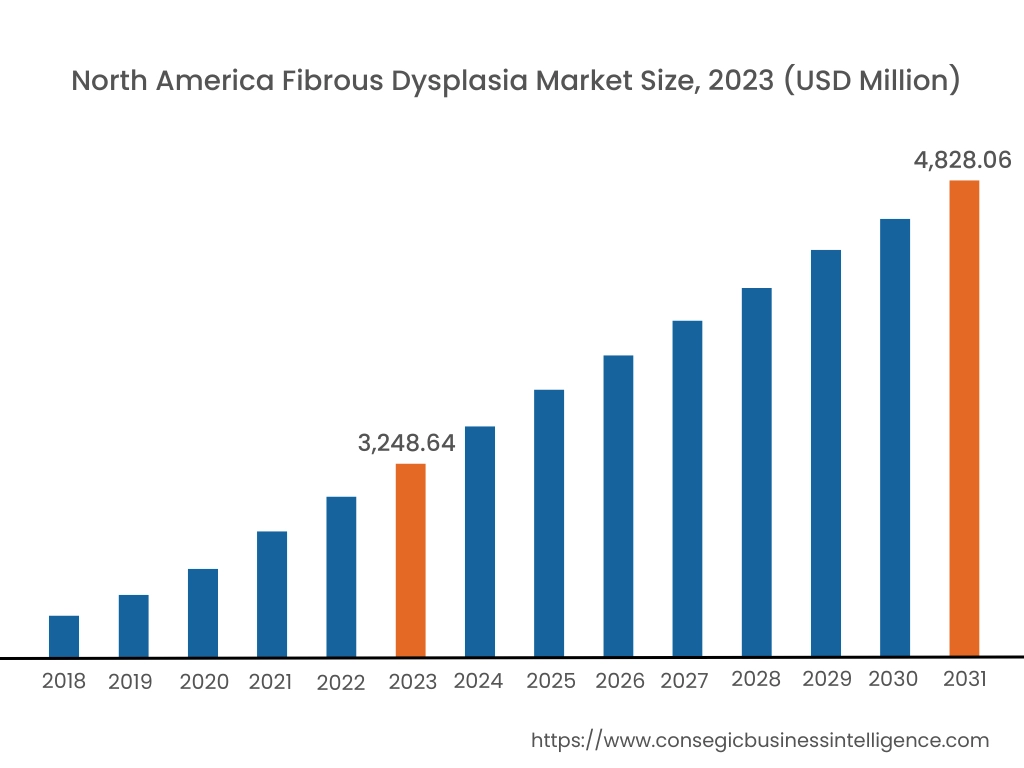
Asia Pacific region was valued at USD 2,561.43 million in 2024. Moreover, it is projected to grow by USD 2,654.78 million in 2025 and reach over USD 3,931.60 million by 2032. Out of this, China accounted for the maximum revenue share of 28.67%. The market is mainly driven by the rising number of highly advanced facilities in countries such as Japan, South Korea, and Singapore. Further, the increasing investment in the field of healthcare for infrastructure development and others is fueling the market progress.
- For instance, in 2024, Rainbow Children Hospital in India provides treatment for children with fibrous dysplasia. The hospital staff of pediatric orthopedic specialists are well-suited to identify conditions with their extensive training and experience in this field.
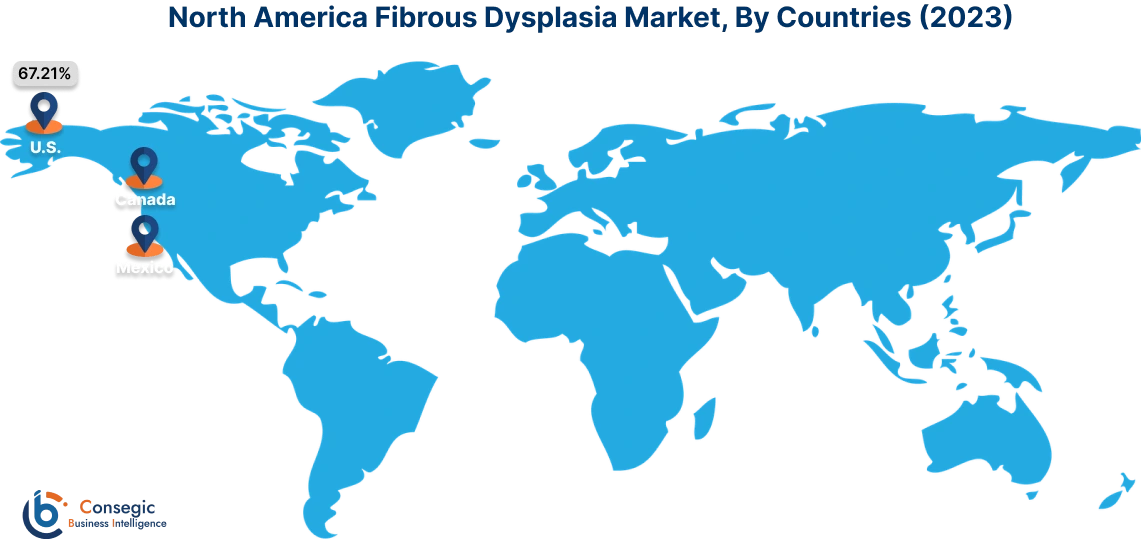
North America is estimated to reach over USD 5,098.80 million by 2032 from a value of USD 3,353.05 million in 2024 and is projected to grow by USD 3,472.49 million in 2025. The North American region's growing number of medical facilities equipped with advanced diagnostic and treatment technologies, such as MRI machines, CT scanners, and others, offers lucrative growth prospects for the market. Additionally, the increasing demand for diagnosing and managing complex conditions is driving the market progress.
- For instance, in April 2023, the US National Institutes of Health (NIH) found that denosumab substantially decreased unusual bone turnover in adult patients. The participants' scans and bone samples revealed a reduction in bone turnover in lesions at the end of the therapy period.
The regional evaluation depicts that the well-developed healthcare system, as well as the use of a multidisciplinary approach to manage the disease, is driving the industry in Europe. Additionally, the key prospect driving the industry is increasing investment in improving the healthcare systems, is propelling the market adoption in the Middle East and African region. Further, the modernization of medical facilities as well as rising need for management and treatment of the disease is paving the way for the progress of market in the Latin American region.
Top Key Players & Market Share Insights:
The global fibrous dysplasia market is highly competitive, with major players providing solution to the national and international markets. Key players are adopting several strategies in research and development (R&D), product innovation, and end user launches to hold a strong position in the fibrous dysplasia industry. Key players in the fibrous dysplasia market include-
- Novartis AG (Switzerland)
- Amgen Inc. (USA)
- Pfizer Inc. (USA)
- Eli Lilly and Company (USA)
- Regeneron Pharmaceuticals, Inc. (USA)
- Ipsen S.A. (France)
- Merck & Co., Inc. (USA)
- Teva Pharmaceutical Industries Ltd. (Israel)
- Sanofi S.A. (France)
- Bayer AG (Germany)
Fibrous Dysplasia Market Report Insights :
| Report Attributes | Report Details |
| Study Timeline | 2018-2031 |
| Market Size in 2031 | UUSD 14,626.50 Million |
| CAGR (2024-2031) | 5.5% |
| By Type |
|
| By Diagnosis |
|
| By Treatment Type |
|
| By End-User |
|
| By Region |
|
| Key Players |
|
| North America | U.S. Canada Mexico |
| Europe | U.K. Germany France Spain Italy Russia Benelux Rest of Europe |
| APAC | China South Korea Japan India Australia ASEAN Rest of Asia-Pacific |
| Middle East and Africa | GCC Turkey South Africa Rest of MEA |
| LATAM | Brazil Argentina Chile Rest of LATAM |
| Report Coverage |
|
Key Questions Answered in the Report
How big is the fibrous dysplasia market? +
The fibrous dysplasia market size is estimated to reach over USD 14,626.50 million by 2032 from a value of USD 9,786.09 million in 2024 and is projected to grow by USD 10,120.02 million in 2025, growing at a CAGR of 5.5% from 2025 to 2032.
Which segmentation details are covered in the fibrous dysplasia report? +
The fibrous dysplasia report includes specific segmentation details for type, diagnosis, treatment type, end user, and regions.
Which is the fastest segment anticipated to impact the market growth? +
In the fibrous dysplasia market, genetic testing is the fastest-growing segment during the forecast period due to advancements in technology to provide more precise diagnoses and personalized treatment approaches.
Who are the major players in the fibrous dysplasia market? +
The key participants in the fibrous dysplasia market are Novartis AG (Switzerland), Amgen Inc. (USA), Merck & Co., Inc. (USA), Teva Pharmaceutical Industries Ltd. (Israel), Pfizer Inc. (USA), Eli Lilly and Company (USA), Ipsen S.A. (France), Sanofi S.A. (France), Bayer AG (Germany), and Regeneron Pharmaceuticals, Inc. (USA) and others.
What are the key trends in the fibrous dysplasia market? +
The fibrous dysplasia market is being shaped by several key trends, including the integration of AI and machine learning into diagnostic imaging for detection and analysis of fibrous dysplasia lesions, as well as continuous advancement in genetic mutations for a better understanding of the condition associated with fibrous dysplasia and other.
